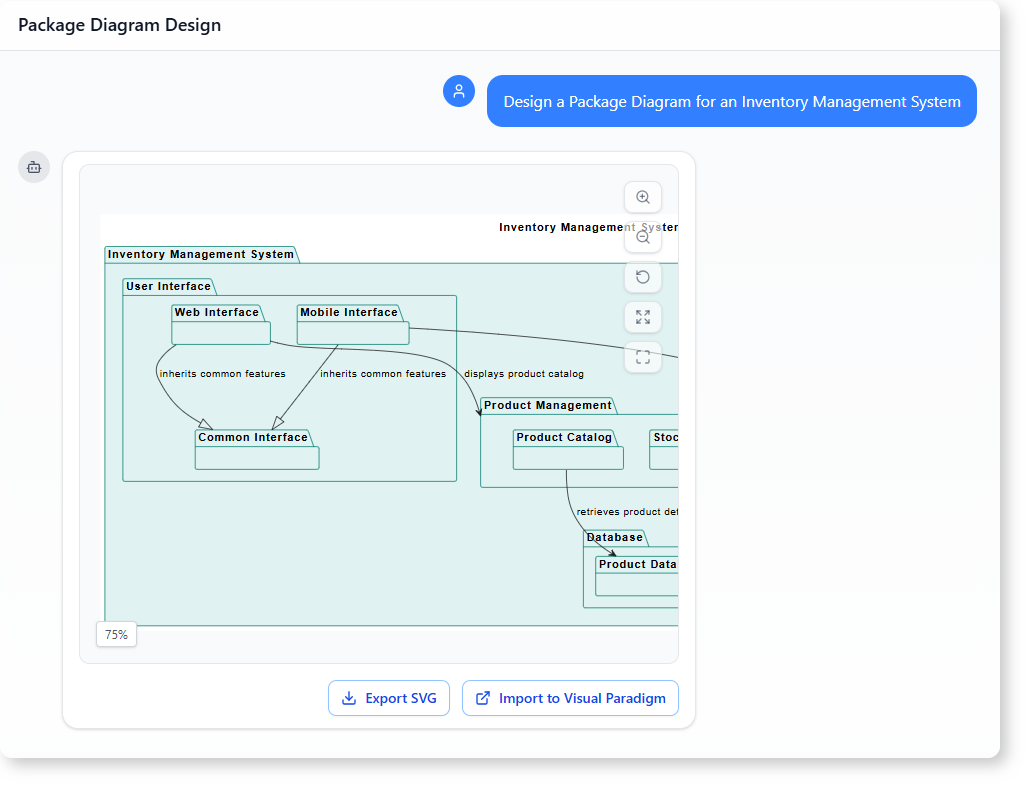Now Reading: How to Use AI-Powered Modeling Software for Inventory Management Systems
-
01
How to Use AI-Powered Modeling Software for Inventory Management Systems
How to Use AI-Powered Modeling Software for Inventory Management Systems
How to Use AI-Powered Modeling Software for Inventory Management Systems
Imagine a team trying to build an inventory management system — from product catalog to warehouse operations — without a clear structure. The result? A messy, fragmented design that doesn’t reflect how the system actually works.
With AI-powered modeling software, this process becomes straightforward. You don’t need to manually draw every package or trace every connection. Just describe the system, and the tool generates a clear, accurate package diagram with meaningful dependencies.
This article walks through a real-world use case: designing a package diagram for an inventory management system. It shows exactly how a user interacts with the AI-powered modeling software to create a structured, dependency-aware view of the system.

The User’s Background and Objective
The user is part of a software development team building a new inventory management system for a retail business. The team is at an early stage — they have clear business goals but no technical blueprint.
Their main challenge is to organize the system into manageable, logical parts — packages — while understanding how these parts interact. Specifically, they need to:
- Group system components into coherent packages
- Identify which packages depend on others
- Understand the impact of changes in one area (like stock tracking) on others
They don’t have time to build this manually or rely on static templates. What they need is a simple, intelligent way to generate a structured model.
Step-by-Step Interaction with the AI-Powered Modeling Software
The user starts by asking the AI-powered modeling software to design a package diagram for an inventory management system.
Prompt 1: Design a Package Diagram for an Inventory Management System
The AI analyzes the request and creates a top-down structure of the system, grouping features into logical packages:
- Product Management
- Warehouse Operations
- Database components
- User Interface layers
It arranges these in a clear, readable layout with proper hierarchy and groupings.
Next, the user asks for a deeper insight:
Prompt 2: Describe the dependencies between packages and their potential impact.
The AI goes beyond structure. It identifies how each package interacts with others:
- The product catalog retrieves data from the product database
- Stock tracking accesses stock levels in the stock database
- Receiving and shipping operations update or reduce stock
- Web and mobile interfaces inherit shared features and access product and warehouse data
It also explains the implications of changes. For example, updating the stock database could affect all modules that rely on it, including receiving and shipping.
This level of detail helps the team understand not just what the system is, but how it moves and reacts.
Why This Approach Works
Traditional modeling tools require users to manually define every relationship. That can be error-prone and slow.
AI-powered modeling software fills that gap by:
- Interpreting natural language prompts
- Translating them into well-structured diagrams
- Adding context through dependency and impact analysis
This isn’t just about drawing boxes. It’s about creating a living model that reflects real-world logic.
The result is a model that is both readable and actionable. Teams can use it to:
- Identify bottlenecks
- Plan feature development
- Discuss changes without technical confusion
What You Get from the AI-Powered Modeling Software
With this tool, you don’t just get a diagram. You get:
- A clear package structure that reflects business logic
- Real dependencies between components
- A narrative explanation of how changes in one part affect others
This helps teams avoid designing isolated pieces that don’t work together. Instead, they build systems that are coherent, maintainable, and easy to expand.
The AI doesn’t just generate a visual. It helps you understand the system’s flow and impact.
A Real-World Example in Action
You can see the full interaction, including the prompts and the generated diagram, in this live chat session: https://ai-toolbox.visual-paradigm.com/app/chatbot/?share=4c9e6c55-6275-4979-bdfb-fd0d6a5794bb
Frequently Asked Questions
Q: Can AI-powered modeling software help with dependency impact analysis?
A: Yes. The tool identifies how changes in one package affect others. For example, updating a database can ripple through operations like receiving or shipping.
Q: Is the generated diagram easy to understand for non-technical team members?
A: The diagram is structured clearly, with labeled packages and clear relationships. The AI also explains the dependencies in plain language.
Q: Does the AI create diagrams based on natural language?
A: Yes. You describe the system in simple terms, and the AI translates it into a detailed package diagram with real-world logic.
Q: How does this help in building a system like an inventory management solution?
A: It ensures that the system is organized logically from the start. Teams can see how different parts connect and how changes may affect the whole.
Ready to map out your system’s interactions? Give our AI-powered modeling software a try at Visual Paradigm’s AI Chatbot today!)
